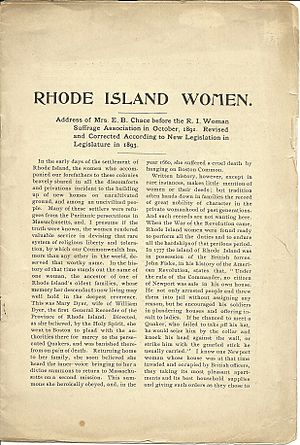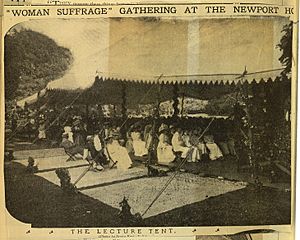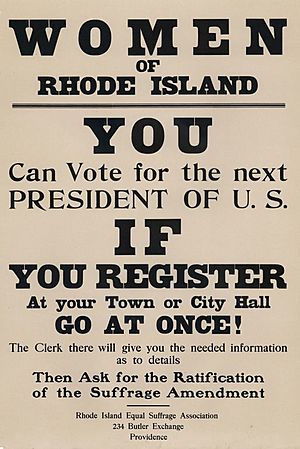Timeline of women's suffrage in Rhode Island facts for kids
This is a timeline showing when women in Rhode Island gained the right to vote. This important movement, called women's suffrage, began with groups working for women's rights. They held meetings and published newspapers to share their ideas. The very first group in Rhode Island focused on women's right to vote was started in 1868.
In 1887, people in Rhode Island voted on a change to the state's rules that would give women the right to vote. This type of vote is called a referendum. Sadly, it did not pass. But the women kept working! In 1917, women in Rhode Island finally won the right to vote in presidential elections. Then, on January 6, 1920, Rhode Island became the 24th state to officially approve, or ratify, the Nineteenth Amendment. This amendment gave all women across the United States the right to vote.
The Fight for Voting Rights in the 1800s

Early Steps in the 1850s
1850
- Paulina Kellogg Wright Davis leads a big meeting called the National Women's Rights Convention in Worcester, Massachusetts.
1852
- Anna W. Spencer publishes a newspaper called The Pioneer and Woman's Advocate. It supported women's rights.
1853
- Paulina Wright Davis starts her own newspaper, The Una, also supporting women's rights.
Forming Groups in the 1860s
1868
- October 23: Elizabeth Buffum Chace and Paulina Kellogg Wright Davis go to the first meeting of the New England Woman Suffrage Association. This group worked for women's voting rights in New England.
- December 11: Elizabeth Buffum Chace and Paulina Wright Davis create Rhode Island's own group, the Rhode Island Woman Suffrage Association (RIWSA).
1869
- The RIWSA asks the Rhode Island General Assembly (the state's law-making group) to change the state rules so women can vote.
Women in Local Elections in the 1870s
1873
- Three women, Elizabeth Churchill, Sarah Elizabeth Doyle, and Rhoda Peckham, try to get elected to the school committee. They do not win this time.
1874
- Three other women, Anna E. Aldrich, Elizabeth C. Hicks, and Abby D. Slocum, are successfully elected to the Providence School Committee. This was a big step!
Big Meetings and Votes in the 1880s
1884
- The RIWSA holds its yearly meeting at the Old Statehouse. Famous leaders like Susan B. Anthony and Frederick Douglass attend.
1885
- A bill to give women the right to vote is brought up in the General Assembly by Representative Edward L. Freeman.
1886
- The bill to change the state rules for women's voting rights passes in both parts of the General Assembly. It needs to pass one more time to be official.
1887
- The women's voting rights bill passes both parts of the General Assembly again! Now, the people of Rhode Island will vote on it.
- April 6: People vote on the amendment, but it does not pass.
- August 11: The New England Woman Suffrage Association holds a meeting in Newport.
Continued Efforts in the 1890s
1892
- A special request is made to the General Assembly. It asks for women in Rhode Island to be able to vote in presidential elections.
1895
- Jeanette S. French speaks at a meeting in the state senate.
1897
- The governor creates a group to update the state's main rules, called the constitution.
- May 11: Women fighting for the right to vote share their concerns with this committee.
The Final Push in the 1900s

Growing Support in the 1900s
1902
- Women working for voting rights in Rhode Island get support from the State Central Trades and Labor Unions. These are groups that represent workers.
1903
- The Mayor of Providence, Daniel L. D. Granger, says he supports women's right to vote.
- Mary H. Dickerson starts the Rhode Island Union of Colored Women's Clubs.
1907
- December: The Rhode Island College Equal Suffrage League is formed. This group brings together college students and teachers who support women's voting rights.
1908
- Cora Mitchell starts the Newport County Woman Suffrage League.
1909
- Alva Belmont, a wealthy supporter of women's rights, hosts several talks about women's voting rights at her home, the Marble House.
Uniting for the Vote in the 1910s
1912
- A group that is against women's voting rights forms a branch in Newport.
1913
- The Rhode Island Women's Suffrage Party is created.
- Bertha G. Higgins convinces the Rhode Island Union of Colored Women's Clubs to support women's voting rights.
1914
- Alva Belmont holds a "Conference of Great Women" at the Marble House.
1915
- Three major groups – the Rhode Island Women's Suffrage Party, RIWSA, and the Rhode Island College Equal Suffrage League – join together to form the Rhode Island Equal Suffrage Association. This makes their efforts stronger.
- September 15: Rhode Island suffragists, Ingeborg Kindstedt and Maria Kindberg, travel across the country by car with Sara Bard Field to promote women's voting rights.
1914
- Margaret Farnum Lippitt, the wife of Governor Charles W. Lippitt, speaks against women voting in presidential elections at the General Assembly.
1916
- February 17: A special lunch is held to honor Carrie Chapman Catt, a national leader in the women's suffrage movement.
- March 6: The Congressional Union of Providence, Rhode Island, is formed.
- The Rhode Island Union of Colored Women's Clubs supports a national amendment to give women the right to vote.
1917
- February 8: Another bill to allow women to vote in presidential elections is introduced.
- April 11: This presidential voting bill passes in the state Senate.
- April 17: The presidential voting bill passes in both parts of the General Assembly.
- April 18: Governor Robert Livingston Beeckman signs the bill into law! Women in Rhode Island can now vote for president.
The Final Victory in the 1920s
1920
- January 6: Rhode Island officially approves the Nineteenth Amendment. This means women across the entire country now have the right to vote!
- October 8: The League of Women Voters of Rhode Island is created. This group helps people understand voting and encourages them to participate.
1928
- Rhode Island removes the rule that you had to own property to vote. This made voting fair for even more people.



